In my last post on overdyeing, I mentioned that blue dye over a green yarn could be lucky, and all day those words haunted me. At home, I have 6 skeins of Gloss Lace in Malachite, a recently discontinued color that is a little cooler (bluer) than the current green, Peapod, offered in that line:
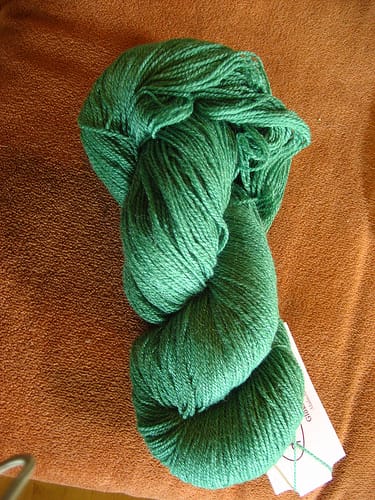
Again, this is a yarn that I bought last year with a specific purpose in mind, which no longer inspires me! I wanted to knit a preppy pink-and green striped sweater, but then realized that I am SO not preppy and the colors I chose were just too subdued for me. So this yarn sat in my stash for a year. Until last weekend:
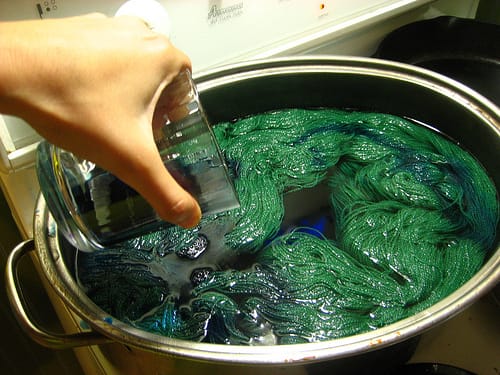
I tied up 3 of the skeins and overdyed them with liberal amounts of Wiltons frosting dye in Violet and Royal Blue. I added a lot of vinegar to the dyebath, because I wanted the dye to strike fast and give a more variegated look. It worked–the dye struck so fast that most of the yarn stayed the original color! I tried to get a picture of it for you, but my camera lens clouded up:
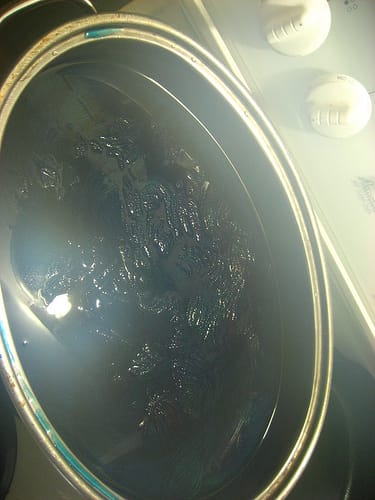
So I added more dye to the bath two times after the initial pour, until I had a color I was happy with. Immensely happy, that is:
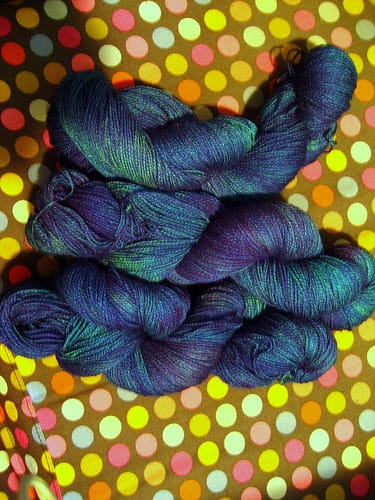
This is one of my favorite ways to dye: Quick and dirty, fueled by inspiration and a desire for creative adventure. I definitely had no idea whether I would ruin this yarn or not, but I had very little to lose, since it wasn’t going to be moving out of my stash very soon in the first place! But now I love these three skeins and am super-excited to knit with them (once I wrap up a few other projects, of course!)
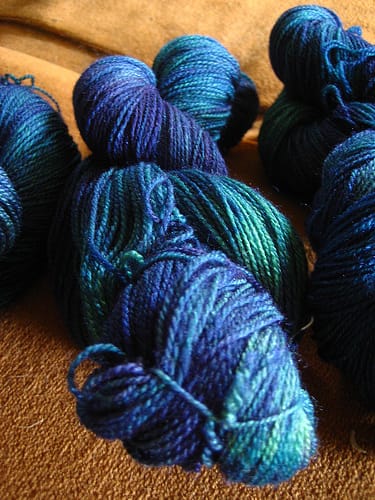
I’m planning a filmy, light summer cardigan out of these and can’t wait to get started on it!
After my last post, I also received a very interesting question from Susan the Blue Lake Knitter, one of the most active members of our online Knitting Community. Susan is planning to spin yarn for an autumn-inspired vest and asked:
… I have 1 1/2 lbs.
of llama/mohair. It has not been spun yet, and I had planned to dye it
first. Should I:
1. spin it up before dyeing
2. dye it with the dark gold (ochre), and then spin, then over dye with the dark red
or
3.dye it with the dark gold, then over dye with the dard red, and then spin.
I thought this was a really interesting question, so with Susan’s permission, I’m sharing it, and my answer with you:
Hi Susan!
All of these are fine ideas; which one you choose depends on the effect
you are going for.
Fiber that is dyed before spinning will produce yarn
with a more even and uniform color than fiber that is dyed after being
spun. That is actually where the expression “dyed in the wool” comes
from! So, if you dye the fiber gold, then red, before spinning, your
finished yarn will probably be a uniform, heathery red-gold mix, rather than
having a handpainted effect like our tonal yarns.
If you want the
hand-painted effect, then you’ll want to spin first and
do both dye processes on the finished yarn.This will allow you to use a variety of dyeing tachniques to acheive the exact variation you want, and will give you complete control over the proportions of the final colors. This will peild the yarn that has the highest contrast, and the highest degree of variety between colors.
And finally, if you want a
semi-solid effect like the yarn I overdyed, I think your best bet would
be to dye the fiber yellow, then spin, and then overdye the finished
yarn with the red dye. This way you will get a very even base of the
yellow and you can slowly add the red in layers over it until you get
what you like. You will not risk having white spots in the yarn, and the red over the yellow can be as subtle or as contrast-y as you like.
Remember that if you are dying a large amount of fiber (and I would
consider 1.5 lbs to be a large amount!) you’ll need a very large pot to
do it all in one go. If you don’t have a pot that large, you’ll want to
take very careful measurement of the amount of dye and water you use in
the dyebath and the amount of fiber that goes into that mix, and
replicate it precisely on every batch of fiber. When you are dyeing the
raw fiber, this may not be as bog of an issue, because you can card the
fiber again before spinning it and the will help blend any uneven parts
of the color. But once the yarn is in the skein, if you want the sheins
to match, take careful notes so they all get dyed the same way.
Of course, you might not even want the skeins to match, which is fine,
too! Keep in mind that red is a much darker dye stock than yellow, so I
would advise using dilute amounts of red and overdying repeatedly until
you get a color you like. Or, you could dye each skein with increasing
amounts of red dye, and end up with a set of skeins which have a
gradient effect. This project sounds like a great way to learn about
the dyeing process and I really look forward to seeing your results!
I hope other members of our community find this discussion as interesting and helpful as I did



